Here is an interesting video about how NOAA is using Automated Surface Vehicles (ASVs) to map the bottom in areas where larger survey craft cannot go. They are essentially drone boats used to update NOAA’s publicly available nautical charts.
 This is an updated repost from 2014. Now that it has been announced that Harriet Tubman will replace Andrew Jackon on the US $20 bill, it seems worthwhile to recall the Great Combahee Ferry Raid, which Harriet Tubman helped plan, scouted and ultimately help lead, becoming the only woman to lead a military raid in US Civil War.
This is an updated repost from 2014. Now that it has been announced that Harriet Tubman will replace Andrew Jackon on the US $20 bill, it seems worthwhile to recall the Great Combahee Ferry Raid, which Harriet Tubman helped plan, scouted and ultimately help lead, becoming the only woman to lead a military raid in US Civil War.
Born a slave, Harriet Tubman escaped and would become a leading “conductor” on the “Underground Railroad” which helped slaves escape from bondage in the South to freedom in the North and in Canada, prior to the Civil War. Nicknamed “Moses,” she is said to have made more than nineteen trips back into the slave-holding South to rescue more than 300 slaves. Her greatest rescue mission, however, came during the Civil War, when she planned and help lead a Union riverboat raid at Combahee Ferry in South Carolina on the second of June, 1863, freeing over 720 slaves.
 Last year, John Doswell, the Executive Director of New York’s Working Harbor Committee, died after a long illness. The Committee is now seeking an Executive Director to continue the great work that John and his colleagues have undertaken. For those interested, click on the link below for the complete job description.
Last year, John Doswell, the Executive Director of New York’s Working Harbor Committee, died after a long illness. The Committee is now seeking an Executive Director to continue the great work that John and his colleagues have undertaken. For those interested, click on the link below for the complete job description.
Working Harbor Committee – Executive Director Job Description
The Working Harbor Committee is a nonprofit organization with a the goal of strengthening awareness of the working harbor’s history and vitality today, and its opportunities for the future. It seeks to involve people in learning how the harbor works and what it does; to educate about the rich and challenging history of the harbor, and to make people aware of the need to build and sustain the working harbor.
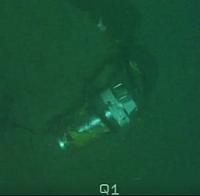 The National Transportation Safety Board (NTSB) announced that “cargo ship El Faro’s voyage data recorder was located early Tuesday morning in 15,000 feet of water, about 41 miles (36 nautical miles) northeast of Acklins and Crooked Islands, Bahamas, by a team of investigators and scientists using remotely operated undersea search equipment.
The National Transportation Safety Board (NTSB) announced that “cargo ship El Faro’s voyage data recorder was located early Tuesday morning in 15,000 feet of water, about 41 miles (36 nautical miles) northeast of Acklins and Crooked Islands, Bahamas, by a team of investigators and scientists using remotely operated undersea search equipment.
The investigative team is comprised of specialists from the National Transportation Safety Board, the U.S. Coast Guard, Woods Hole Oceanographic Institution and Tote Services, the owner and operator of El Faro.
At about 1 a.m. EDT the team aboard the research vessel Atlantis located the El Faro’s mast where the VDR was mounted. After examining numerous images provided by undersea search equipment, the team positively identified the VDR.
 In 1981, Ngoc Nguyen was 13, one of the at least 800,000 of the so-called Vietnamese “boat people” who fled Vietnam by boat after the end of the war. He was crammed in an overcrowded boat with his family, among 65 other refugees adrift in the South China Sea, when they were picked up by the Arnold Maersk. Now 34 years later, took to the bridge of the container ship, Thomas Maersk, as its captain.
In 1981, Ngoc Nguyen was 13, one of the at least 800,000 of the so-called Vietnamese “boat people” who fled Vietnam by boat after the end of the war. He was crammed in an overcrowded boat with his family, among 65 other refugees adrift in the South China Sea, when they were picked up by the Arnold Maersk. Now 34 years later, took to the bridge of the container ship, Thomas Maersk, as its captain.
From Maersk.com: Nguyen remembers his family’s escape in 1981 as if it were yesterday: “Two days had passed since the patrol boat had chased us away from the shores of Vietnam. With only a compass, a dwindling supply of gas and no food or water, our chances of reaching land safely were looking bleak.”
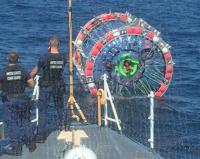 “Bubble Man” Reza Baluchi is at it again, but this time, the Coast Guard told him to turn around not far from shore before putting himself or others in danger. After warning him not to leave port without a support vessel, the US Coast Guard intercepted Baluchi in his inside his Hydropod, a home-made inflatable plastic bubble with a metal frame, about 7 miles off the coast of Jupiter, Florida. Baluchi had announced his intention to run inside the bubble craft on a 3,500-mile five-month trek between Florida and islands in the Atlantic and Caribbean.
“Bubble Man” Reza Baluchi is at it again, but this time, the Coast Guard told him to turn around not far from shore before putting himself or others in danger. After warning him not to leave port without a support vessel, the US Coast Guard intercepted Baluchi in his inside his Hydropod, a home-made inflatable plastic bubble with a metal frame, about 7 miles off the coast of Jupiter, Florida. Baluchi had announced his intention to run inside the bubble craft on a 3,500-mile five-month trek between Florida and islands in the Atlantic and Caribbean.
In October of 2014, we posted about his attempt to run inside his inflatable bubble, which looks a bit like an aquatic hamster cage, on a 1,000-mile voyage from Florida to Bermuda. The Coast Guard rescued him roughly 70 miles off the Florida coast after he became dehydrated and disoriented and triggered an emergency beacon. That rescue cost taxpayers around $140,000, according to the Coast Guard.
I recently visited the museum ship SS Great Britain, in Bristol, UK. When she was launched in 1843, the iron-hulled luxury passenger steamship SS Great Britain was described as “the greatest experiment since the Creation.”
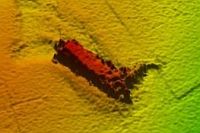
Photo: Kongsberg Maritime
At long last, Nessie has been located on the bottom of Loch Ness! The monster is, however, not the legendary beastie, but instead a 30-foot long movie prop which sank in the Loch almost 50 years ago. The prop was to be used in the filming of “The Private Life of Sherlock Holmes,” directed by Billy Wilder. The model featured a neck and two humps. Director Wilder asked that the humps be removed which adversely affected the model’s buoyancy, causing the model to sink to the lake bottom, where it has been since 1969. A new model, without humps, was built and the scene was shot in a tank rather than the loch.
The model monster was discovered by a robot drone operated by the Norwegian company Kongsberg Maritime, which has been working with VisitScotland and Adrain Shine’s The Loch Ness Project. The Loch Ness Project is gathering scientific information on the loch’s ecology, as well as keeping an eye out for the legendary monster.
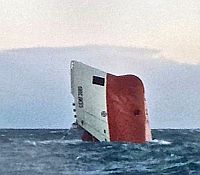 In January of 2015, we posted about the capsize and sinking of the Cyprus-registered cement carrier MV Cemfjord while attempting to navigate the Pentland Firth in extremely rough weather. Eight officers and crew aboard died in the sinking. The UK’s Marine Accident Investigation Branch (MAIB) issued its report on the casualty stating that the sinking could have been avoided if the captain sought refugee rather than continuing.
In January of 2015, we posted about the capsize and sinking of the Cyprus-registered cement carrier MV Cemfjord while attempting to navigate the Pentland Firth in extremely rough weather. Eight officers and crew aboard died in the sinking. The UK’s Marine Accident Investigation Branch (MAIB) issued its report on the casualty stating that the sinking could have been avoided if the captain sought refugee rather than continuing.
In his statement to the media, Steve Clinch, The Chief Inspector of Marine Accidents stated:
 Yesterday, we posted about a project to recreate sailor’s grub from the 17th century. Food for sailors has improved dramatically in the last three hundred years. Or has it? The Naval Historical Foundation has a new blog titled CHOW which explores the history behind U.S. Navy culinary traditions. A recent blog post looks at creamed sliced beef on toast, a Navy and Army breakfast, served for breakfast and universally known as “S__t on a Shingle” or “S.O.S.”
Yesterday, we posted about a project to recreate sailor’s grub from the 17th century. Food for sailors has improved dramatically in the last three hundred years. Or has it? The Naval Historical Foundation has a new blog titled CHOW which explores the history behind U.S. Navy culinary traditions. A recent blog post looks at creamed sliced beef on toast, a Navy and Army breakfast, served for breakfast and universally known as “S__t on a Shingle” or “S.O.S.”
From their post: The exact origin of S.O.S. is fuzzy. According to Wentworth and Flexner’s 1967 Dictionary of American Slang, no specific origin is known. The dish, which consists of sliced dried beef mixed in a thick creamy gravy, appeared in military cookbooks at the start of the twentieth century. Some cooking sources, such as the online website “Seabee Cook,” claim the dish came from the Army. Steve Karoly, who authored an article on the subject, claims the “Army favorite” has become “the most popular version of SOS.” Some Navy veterans may disagree.
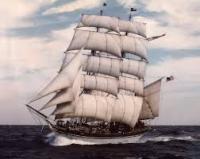 What we know of the diet of 17th-century sailors comes from written records — log entries, diaries, and journals. Most accounts say that it was pretty bad. Now, Grace Tsai, a Ph.D. student specializing in nautical archaeology at Texas A&M University, wants to investigate sailor’s grub, by recreating the food as accurately as possible. Ms. Tsai and her team have been working to prepare salt beef, ship’s biscuit, cheese, beer and wine as they were made and stored in the 17th century. In August, Ms. Tsai and her team will embark with their period rations on a simulated three-month voyage on the tall ship Elissa in Galveston, Texas. The food will be sampled every ten days for nutritional and microbial analysis over a period of three months.
What we know of the diet of 17th-century sailors comes from written records — log entries, diaries, and journals. Most accounts say that it was pretty bad. Now, Grace Tsai, a Ph.D. student specializing in nautical archaeology at Texas A&M University, wants to investigate sailor’s grub, by recreating the food as accurately as possible. Ms. Tsai and her team have been working to prepare salt beef, ship’s biscuit, cheese, beer and wine as they were made and stored in the 17th century. In August, Ms. Tsai and her team will embark with their period rations on a simulated three-month voyage on the tall ship Elissa in Galveston, Texas. The food will be sampled every ten days for nutritional and microbial analysis over a period of three months.
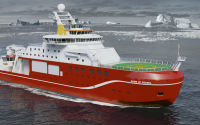 We previously posted about how the British Natural Environment Research Council (NERC) was asking for suggestions for a name for the new polar research ship, currently under construction at Cammell Laird’s yard in Birkenhead. The suggestion period ended on April 16th and it has been announced that the most popular suggestion by a landslide is “Boaty McBoatface.” The tongue-in-cheek moniker won easily with 124,109 votes.
We previously posted about how the British Natural Environment Research Council (NERC) was asking for suggestions for a name for the new polar research ship, currently under construction at Cammell Laird’s yard in Birkenhead. The suggestion period ended on April 16th and it has been announced that the most popular suggestion by a landslide is “Boaty McBoatface.” The tongue-in-cheek moniker won easily with 124,109 votes.
As reported by Sky News: “Second was RRS Poppy-Mai – named after a 16-month-old girl with terminal cancer – with 34,371 votes. RRS Henry Worsley, commemorating an Antarctic explorer who died in January, was the highest placed suggestion that had scientific links, coming third. RRS It’s Bloody Cold Here, and RRS David Attenborough came fourth and fifth.”
 Last November, we posted that the National Transportation Safety Board (NTSB) had ended its search for the El Faro‘s Voyage Data Recorder (VDR), the so-called “black box,” which might have provided answers to questions about the sinking of the 790-foot long ro/ro-container ship. El Faro was lost in Hurricane Joaquin with the loss of 33 crew in the beginning of October in 2015. The wreckage of the ship was located off Crooked Island in the southeastern Bahamas. Now the NTSB has restarted the search using a “sophisticated autonomous underwater vehicle”, AUV Sentry.
Last November, we posted that the National Transportation Safety Board (NTSB) had ended its search for the El Faro‘s Voyage Data Recorder (VDR), the so-called “black box,” which might have provided answers to questions about the sinking of the 790-foot long ro/ro-container ship. El Faro was lost in Hurricane Joaquin with the loss of 33 crew in the beginning of October in 2015. The wreckage of the ship was located off Crooked Island in the southeastern Bahamas. Now the NTSB has restarted the search using a “sophisticated autonomous underwater vehicle”, AUV Sentry.
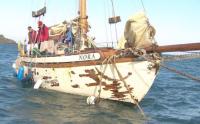 Steve Shapiro’s frequently rescued sailboat Nora, has been sold. In January, we posted about a pair of American sailors who had been rescued nine times in sailing from Norwalk to Cornwell in the UK on a 40′ gaff rigged sloop named Nora. The two sailors, Bob Weise and Steve Shapiro, both 71, had been attempting to sail across the Atlantic from Norway to Maine but had suffered a variety of breakdowns and groundings which resulted in calling for help from rescue teams from Norway, Scotland, Ireland and the UK.
Steve Shapiro’s frequently rescued sailboat Nora, has been sold. In January, we posted about a pair of American sailors who had been rescued nine times in sailing from Norwalk to Cornwell in the UK on a 40′ gaff rigged sloop named Nora. The two sailors, Bob Weise and Steve Shapiro, both 71, had been attempting to sail across the Atlantic from Norway to Maine but had suffered a variety of breakdowns and groundings which resulted in calling for help from rescue teams from Norway, Scotland, Ireland and the UK.
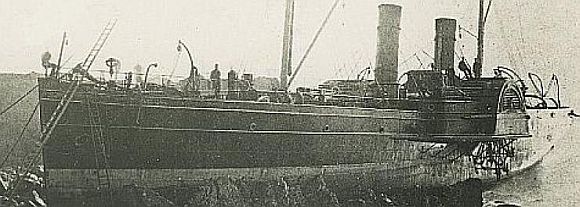 The Confederate blockade runner Agnes E. Fry is believed to have been located off Oak Island, North Carolina. She is one of three blockade runners lost in the area during the Civil War, but the only ship longer than 200 feet. The Agnes E. Fry was a 559-ton iron side-wheel steamer built by Caird & Company at Greenock, on the River Clyde in 19864. The blockade runner was 237 feet long by 25 feet in beam, with a depth of hold of 13 feet. She made two successful runs into Wilmington before being lost on her third attempted voyage, two days after Christmas 1864.
The Confederate blockade runner Agnes E. Fry is believed to have been located off Oak Island, North Carolina. She is one of three blockade runners lost in the area during the Civil War, but the only ship longer than 200 feet. The Agnes E. Fry was a 559-ton iron side-wheel steamer built by Caird & Company at Greenock, on the River Clyde in 19864. The blockade runner was 237 feet long by 25 feet in beam, with a depth of hold of 13 feet. She made two successful runs into Wilmington before being lost on her third attempted voyage, two days after Christmas 1864.
In observance of the anniversary of the sinking of the Titanic on April 15, 1912, here is a repost from 2012, about two hardy souls who survived not only the sinking of the RMS Titanic but also the RMS Britannic when she was sunk by a mine and the RMS Olympic when she collided with the HMS Hawke.
Arthur John Priest was a stoker, or fireman, on the RMS Titanic. His job was to shovel coal into the ship’s boilers. He survived the Titanic’s sinking of 1912. He also was aboard the RMS Olympic, the sistership to the Titanic, when she collided with HMS Hawke in 1911.
Priest was also aboard the Britannic, the third sistership to the Olympic and the Titanic when she hit a mine and sank in 1916. Priest also survived the World War I losses of the Alcantara and Donegal. He once claimed that he was forced to retire from the sea by these disasters because no one wished to sail with him. Priest died at the age of 50 of pneumonia Southampton.

Violet Jessop
More famous and longer lived than Priest was Violet Jessop, a nurse who was coincidentally also onboard the RMS Olympic during the collision with HMS Hawk and during the sinkings of both the Titanic and the Britannic. Ms. Jessop died of heart failure at the age of 84. Characters based on Ms. Jessop have appeared in two movies and a play about the sinking of the Titanic.
 The Russians do not appear to like the US Navy operating ships in the Baltic Sea. On Aprill 11, two unarmed Russian SU24 fighter jets made low attitude passes at the US Navy destroyer USS Donald Cook. Then, on April 12, two Russian KA27 Helix helicopters flew several circles around the Donald Cook, apparently taking photos. Later, two unarmed SU24 jets made approximately a dozen very close, low-level passes of the ship in what the official described as “Simulated Attack Profile.” When the incidents took place the Donald Cook was roughly 70 nautical miles from the Russain port of Kaliningrad in international waters in the Baltic Sea, having sailed from Gdynia, Poland.
The Russians do not appear to like the US Navy operating ships in the Baltic Sea. On Aprill 11, two unarmed Russian SU24 fighter jets made low attitude passes at the US Navy destroyer USS Donald Cook. Then, on April 12, two Russian KA27 Helix helicopters flew several circles around the Donald Cook, apparently taking photos. Later, two unarmed SU24 jets made approximately a dozen very close, low-level passes of the ship in what the official described as “Simulated Attack Profile.” When the incidents took place the Donald Cook was roughly 70 nautical miles from the Russain port of Kaliningrad in international waters in the Baltic Sea, having sailed from Gdynia, Poland.
The US Navy posted videos of the Russian planes buzzing the Cook on Youtube.
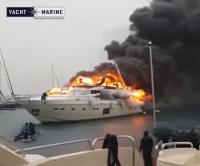 The headlines in the UK Daily Mail and Bloomberg ask the same question — “Why Are All These Superyachts Catching on Fire?” This year has seen a string of fires on “superyachts.” In early January, in the Mediterranean resort town of Marmaris, Turkey, a fire broke out on the 239′ yacht The One before spreading to the 170′ yacht Barbie. Later in January, the 95′ yacht Queen Anna was destroyed by fire at a marina in Fethiye, Turkey. In early March, a fire broke out at the Abu Dhabi Marina Yacht Club, destroying eight yachts, three of which were over 90′ long, including the 101′ yacht Asfar. Also in March the 77′ yacht Positive Energy went up in flames at Charlotte Amalie harbor on St Thomas, in the Virgin Islands.
The headlines in the UK Daily Mail and Bloomberg ask the same question — “Why Are All These Superyachts Catching on Fire?” This year has seen a string of fires on “superyachts.” In early January, in the Mediterranean resort town of Marmaris, Turkey, a fire broke out on the 239′ yacht The One before spreading to the 170′ yacht Barbie. Later in January, the 95′ yacht Queen Anna was destroyed by fire at a marina in Fethiye, Turkey. In early March, a fire broke out at the Abu Dhabi Marina Yacht Club, destroying eight yachts, three of which were over 90′ long, including the 101′ yacht Asfar. Also in March the 77′ yacht Positive Energy went up in flames at Charlotte Amalie harbor on St Thomas, in the Virgin Islands.
 The Navy’s newest destroyer, the $7.5 billion USS Zumwalt, is designed to be stealthy. The ship is intended to be 50 times harder to detect on radar than current destroyers thanks to its angular shape and other design features. This is turning out to be a problem. The ship is now undergoing sea trial and testing off the often foggy coast of Maine. She is apparently very difficult for local boats to spot.
The Navy’s newest destroyer, the $7.5 billion USS Zumwalt, is designed to be stealthy. The ship is intended to be 50 times harder to detect on radar than current destroyers thanks to its angular shape and other design features. This is turning out to be a problem. The ship is now undergoing sea trial and testing off the often foggy coast of Maine. She is apparently very difficult for local boats to spot.
Lawrence Pye, a lobsterman, told The Associated Press that on his radar screen the 610-foot ship looked like a 40- to 50-foot fishing boat. He watched as the behemoth came within a half-mile while returning to shipbuilder Bath Iron Works. “It’s pretty mammoth when it’s that close to you,” Pye said.
So, what is to be done? Gizmodo is reporting that the Navy plans to install removable radar reflectors to avoid wreaking havoc on local mariners.
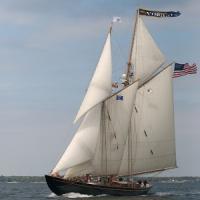 In the Summer of 2014, the schooner Virginia ended her season early. The Virginia Maritime Heritage Foundation which operated the schooner announced that she would be put up for sale. Now, Nauticus, a maritime-themed science center and museum located on the downtown waterfront in Norfolk, Virginia, is planning to buy the schooner with funds from a $1 million state grant. $850,000 will go to purchase the schooner, with the remained used for maintenacne and upkeep.
In the Summer of 2014, the schooner Virginia ended her season early. The Virginia Maritime Heritage Foundation which operated the schooner announced that she would be put up for sale. Now, Nauticus, a maritime-themed science center and museum located on the downtown waterfront in Norfolk, Virginia, is planning to buy the schooner with funds from a $1 million state grant. $850,000 will go to purchase the schooner, with the remained used for maintenacne and upkeep.
The schooner Virginia is a reproduction of the last all sail pilot vessel built for the Virginia Pilot Association. She is 114′ on deck and sets 6,538 square feet of sail. The original ship sailed for the pilots from 1917-1926, training apprentice pilots in seamanship and navigation. The reproduction was built in Norfolk between 2002-2004. The Nauticus Foundation plans to use the schooner as part of Sail Nauticus, a program that gives underprivileged children around Hampton Roads access to the water.

